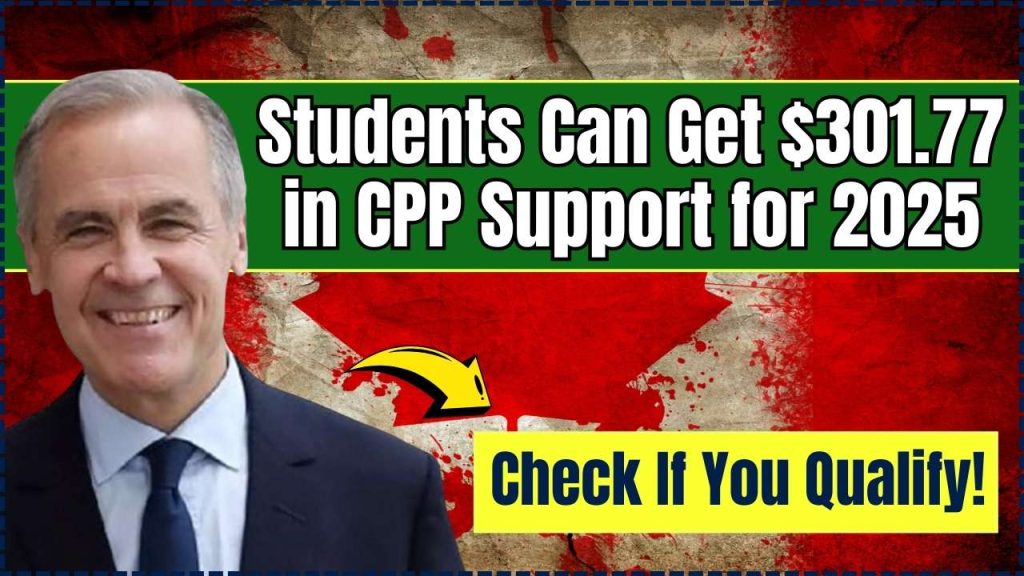
CPP Support for 2025: If you’re a student in Canada and one of your parents is either receiving CPP disability payments or has passed away after contributing to the Canada Pension Plan (CPP), you may be eligible for monthly financial support. In 2025, this benefit amounts to $301.77 per month for eligible full-time students — a much-needed boost to help cover tuition, textbooks, transportation, and essential living expenses.
As the cost of education and inflation continue to rise, every dollar counts for students and their families. This CPP children’s benefit ensures that students are not left behind due to financial challenges stemming from family disability or loss. Whether you’re just starting your post-secondary education journey or already halfway through your degree, this benefit could ease a significant part of your financial burden.
CPP Support for 2025
| Feature | Details |
|---|---|
| Monthly CPP Benefit | $301.77/month in 2025 for eligible students |
| Age Requirement | 18 to 24 years old |
| Eligibility | Parent must be receiving CPP disability or be deceased after CPP contributions |
| Student Status | Must be enrolled full-time in a recognized post-secondary institution |
| Part-Time Students | Eligible for 50% of the full-time amount as of Jan 1, 2025 |
| Taxable Income? | Yes, benefits are considered taxable |
| Application Mode | Apply via Service Canada with required documents |
The $301.77/month CPP children’s benefit in 2025 is more than just financial aid—it’s a pathway to opportunity for students facing challenging family circumstances. Whether you’re continuing high school, starting college, or navigating university, this monthly support can help you stay focused on your education.
Be proactive: check your eligibility, prepare your documents, and apply early. Keep your information updated, file your taxes, and reapply every year with proof of enrollment to avoid interruptions.
What Is the CPP Children’s Benefit?
The CPP children’s benefit is a monthly payment made by the Government of Canada to help the dependent children of individuals who have either become disabled or passed away after making contributions to the Canada Pension Plan. This benefit acts as a financial lifeline, helping young Canadians pursue higher education when they might otherwise be forced to delay or cancel their plans due to financial constraints.
There are two types of CPP children’s benefits:
- Disabled contributor’s child benefit – for children whose parent is currently receiving CPP disability payments.
- Survivor’s child benefit – for children whose parent has passed away but had contributed to CPP long enough to qualify.
To receive the benefit, the parent must have met minimum contribution requirements under the CPP system, typically involving valid contributions for a set number of years depending on age and circumstances.
Who Is Eligible for the $301.77 CPP Support in 2025?
To receive the full $301.77 monthly benefit in 2025, the student and their parent or guardian must meet the following eligibility criteria:
Age Criteria
- The student must be between 18 and 24 years old.
Education Requirements
- Must be enrolled full-time in a recognized post-secondary institution, such as a college, university, or vocational program.
- If turning 18 while still in high school, students can still apply as long as they remain enrolled full-time.
Parental Requirements
- The student’s parent or legal guardian must be receiving CPP disability benefits, or
- The parent must have passed away after making sufficient contributions to the Canada Pension Plan.
New Part-Time Provision (Effective January 2025)
In a welcome change, part-time students are now eligible to receive 50% of the full-time benefit, amounting to $150.88 per month. This opens the door for more students who juggle work and study or face health issues that prevent full-time enrollment.
How to Apply for the CPP Children’s Benefit
Applying is a straightforward process, but accuracy and timing are key. Here’s how to do it right:
Step 1: Gather Required Documents
- Proof of enrollment: A letter or official document from your school confirming your current full-time status.
- Social Insurance Number (SIN): Required for identity verification.
- Direct deposit banking details: To receive payments faster and securely.
- Government-issued identification: Such as a driver’s license, passport, or provincial/territorial ID card.
Step 2: Complete the Application Form
- Fill out CPP Children’s Benefit Application Form (ISP1400).
- This form is available for download at the Service Canada website or can be completed via your My Service Canada Account online.
Step 3: Submit the Application
- Online: Upload all documents securely through your online Service Canada account.
- By Mail: Send the filled application and all documents to your nearest Service Canada office.
Important: The benefit is not automatically extended past age 18. You must reapply each school year with updated proof of enrollment.
When Will You Get Paid?
Once your application is approved, payments begin shortly thereafter. CPP children’s benefits are paid monthly, usually within the last three business days of each month.
Example Payment Dates for 2025:
- January – January 29
- February – February 26
- March – March 27
- April – April 29
It’s best to apply early and keep your documents up to date to avoid missing out on payments.
Is the CPP Student Benefit Taxable?
Yes, this benefit is considered taxable income. You will receive a T4A slip at tax time. Even if your total income is below the federal tax-free threshold ($15,705 in 2025), you still need to report it on your return.
Tax Tip:
If your income is low enough, you may be eligible for GST/HST credits or provincial tax rebates. Filing your taxes ensures you receive any additional supports for which you qualify.
Example Calculation: What Can You Receive?
Let’s say you are eligible for the full-time benefit:
Sophie, age 19, is studying full-time at a university in Ontario. Her father passed away but contributed to CPP for over 20 years. She qualifies for the survivor’s child benefit.
She receives $301.77 per month:
- Over a year (12 months): $3,621.24
- Over three years of study: $10,863.72
If Sophie switches to part-time due to health reasons or work commitments, she would still receive about $150.88/month.
Carlos, age 22, is pursuing a diploma at a vocational college in Alberta. His mother is receiving CPP disability benefits. He qualifies for the disabled contributor’s child benefit and receives $301.77/month as long as he remains enrolled full-time.
Tips for Maximizing This Benefit
- Apply immediately after turning 18 if eligible.
- Set calendar reminders to renew your proof of enrollment each academic year.
- Keep multiple copies of your documents.
- Ensure accuracy when entering information to avoid delays.
- Notify Service Canada of any changes in student status, address, or bank details.
- Use direct deposit to avoid delays and mail issues.
- Talk to your financial aid office if you need help with the application process.
Canada’s Small Business Carbon Rebate: Check Eligibility Criteria and Payment Dates!
$8396 Age Amount Tax Credit in Canada: Are You Eligible to Get it? Check Details!
$300 Federal Payment in Canada for 2025 – Check Important Dates, Amount, and Eligibility Criteria!
Frequently Asked Questions About CPP Support for 2025
Can I apply if I’m still in high school?
Yes. If you are 18 or older and studying full-time in high school, you can apply for the CPP children’s benefit.
What happens if I drop out or take a gap year?
The benefit will stop if you are no longer enrolled full-time or become ineligible. Always inform Service Canada to avoid overpayments.
Can I receive retroactive payments?
Yes. If you were eligible within the past 12 months but didn’t apply, you may still receive back payments, provided you submit documentation.
Do both parents have to be deceased or disabled?
No. You only need one parent to be receiving CPP disability benefits or to have passed away after sufficient CPP contributions.
Can international students apply?
Unfortunately, only Canadian citizens or permanent residents whose parent(s) qualify under CPP are eligible.











